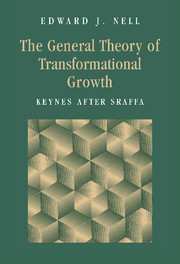Book contents
- Frontmatter
- Contents
- Preface
- Acknowledgments
- Part I History or equilibrium?
- Part II Method and approach: the active mind
- Part III Money and the Golden Rule
- PART IV The wage-profit trade-off
- Part V Investment and Mass Production
- Part VI Money and fluctuations in the modern economy
- 12 Money and interest in the Keynesian system
- 13 Growth and cycles: financially constrained instability under Mass Production
- Conclusions
- Bibliography
- Index
12 - Money and interest in the Keynesian system
Published online by Cambridge University Press: 21 January 2010
- Frontmatter
- Contents
- Preface
- Acknowledgments
- Part I History or equilibrium?
- Part II Method and approach: the active mind
- Part III Money and the Golden Rule
- PART IV The wage-profit trade-off
- Part V Investment and Mass Production
- Part VI Money and fluctuations in the modern economy
- 12 Money and interest in the Keynesian system
- 13 Growth and cycles: financially constrained instability under Mass Production
- Conclusions
- Bibliography
- Index
Summary
The Keynesian system emerged at a critical juncture when the economy was shifting from Craft-based factories to Mass Production. It embodies aspects of both systems. Diminishing returns are assumed; the real wage is supposed to move inversely to output and employment. Prices are flexible – but so are employment and output. Demand changes have multiplier effects. Investment can be volatile. The system may not adjust properly and certainly need not adjust to full employment. Money is nonneutral and monetary factors may prove to be destabilizing.
Keynes offered two new features in the General Theory: one was its theory of output – that output adjusts to bring savings into line with investment. The central insight is surely correct. What the preceding chapters have done is first to relate it to income – that is, wages and profits, and secondly, to dovetail it with the working of demand pressure in the Marshallian system, in order to show the changing character of market adjustment to variations in demand pressure as technology and institutions developed. In the world of Craft-based factories markets adjust chiefly through prices, after the development of Mass Production, through quantities.
The other was his theory of money. Its value is anchored in money wages, and variations in its quantity affect not prices, but interest rates. The centerpiece of the theory is liquidity preference, the idea that the rate of interest is determined by the supply and demand for money as an asset.
- Type
- Chapter
- Information
- The General Theory of Transformational GrowthKeynes after Sraffa, pp. 613 - 653Publisher: Cambridge University PressPrint publication year: 1998



